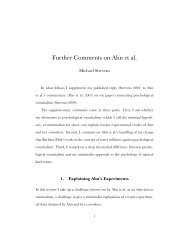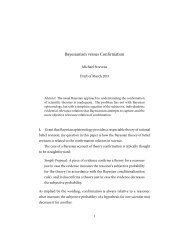The Essentialist Aspect of Naive Theories - Michael Strevens
The Essentialist Aspect of Naive Theories - Michael Strevens
The Essentialist Aspect of Naive Theories - Michael Strevens
Create successful ePaper yourself
Turn your PDF publications into a flip-book with our unique Google optimized e-Paper software.
1.3 Internal Essentialism<br />
<strong>The</strong> pure and statistical essentialist hypotheses allow that children may represent<br />
the existence <strong>of</strong> essences while having no beliefs at all about the sorts<br />
<strong>of</strong> things essences are (although they may well acquire such beliefs as they<br />
grow older).<br />
What I will call internal essentialism is pure essentialism with one additional<br />
tenet: from the time they start making K-patterned inferences, children have<br />
a firm belief about the nature <strong>of</strong> essences, namely, that an essence is a property<br />
<strong>of</strong> some or all <strong>of</strong> an entity’s insides. It might be the entire insides, or<br />
just something buried within (the heart or the DNA, say). <strong>The</strong> hypothesis<br />
allows that (and it is expected that) children do not know where the essential<br />
part <strong>of</strong> the insides is located or what property <strong>of</strong> that essential part is the<br />
essence. What it rules out, unlike pure essentialism, are possibilities such as<br />
the following: (a) children represent the essence <strong>of</strong> a tiger as being a property<br />
<strong>of</strong> the tiger’s skin (or as any aspect <strong>of</strong> the tiger’s external appearance),<br />
(b) children have no beliefs about the location or nature <strong>of</strong> essences, and (c)<br />
children represent the essence as some aspect <strong>of</strong> the causal history <strong>of</strong> the<br />
tiger, such as a fact about its parents or its evolutionary lineage.<br />
It is <strong>of</strong>ten unclear whether advocates <strong>of</strong> psychological essentialism are<br />
pure essentialists or internal essentialists, but essences are <strong>of</strong>ten described<br />
as “deep” or “underlying” (see for example Atran (1995, 219–20)), and<br />
many experiments hint that insides play an important role in generating<br />
the K-patterns <strong>of</strong> inference (for example, S. Gelman and Wellman (1991)).<br />
Related research has suggested that children see insides as doing some <strong>of</strong><br />
the work that pure essentialism attributes to essences (R. Gelman, 1990;<br />
S. Gelman & Kremer, 1991). Thus whether or not internal essentialism<br />
has previously been clearly distinguished from pure essentialism, it is, so to<br />
speak, “in the air”.<br />
<strong>The</strong> tenets <strong>of</strong> internal essentialism are the following:<br />
1. Some naive theories posit a special role for a certain key property (or<br />
properties) <strong>of</strong> an entity’s insides, the essential property, though they may<br />
not represent which property this is.<br />
2. Essential properties are represented as what define the categories <strong>of</strong> a<br />
theory, in the sense that possession <strong>of</strong> the essential property is represented<br />
as necessary and sufficient for category membership.<br />
6






